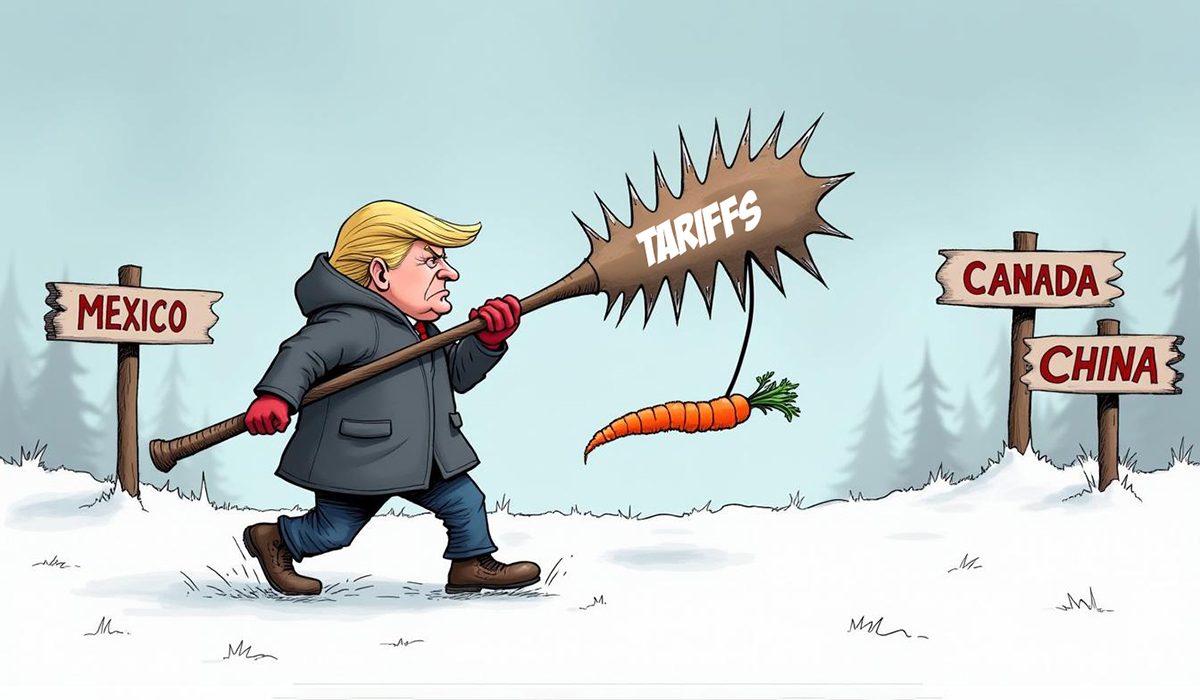US Trade Tariffs: Economic Impact, Risks, and Strategies for Businesses
President Donald Trump announced a 25% tariff on most goods imported from Mexico and Canada, with energy products from Canada facing a lesser 10% tariff. Additionally, a 10% tariff will be imposed on all goods from China. These tariffs were initially scheduled to take effect on February 4 but have been postponed for 30 days following last-minute negotiations. The White House states that these actions aim to advance U.S. priorities on immigration and drug trafficking, though specific goals and conditions for lifting the tariffs remain unclear.
This blog examines the economic implications of these tariffs, potential global reactions, and strategies businesses can adopt to mitigate risks.
Economic impact on Canada and global trade
The U.S. trade war introduces significant risks for Canada’s economy, affecting growth, business investment, and market stability. To assess the economic impact, three key factors are considered:
1. Magnitude of the tariffs – The 25% and 10% tariffs represent a substantial cost increase for affected industries.
2. Range of goods affected – The broad scope of the tariffs disrupts multiple industries, particularly automotive, energy, and technology.
3. Duration of the tariffs – Persistent trade barriers could lead to long-term structural economic shifts.
The Bank of Canada modelled a scenario where a 25% permanent tariff on all U.S. imports could create a -2.5% drag on Canada’s GDP in the first year. Increased costs on imports will affect both consumers and businesses, leading to higher prices and declining profit margins, particularly for industries dependent on international supply chains.

Global reactions and retaliation risks
Beyond Canada, global markets will feel the repercussions of these tariffs. Potential responses include:
China’s countermeasures – China may impose retaliatory tariffs on U.S. exports, impacting agriculture, technology, and manufacturing sectors.
Canada and Mexico’s response – Both countries could implement counter-tariffs, affecting U.S. exports and increasing costs for North American businesses.
EU and other nations – Countries with significant trade ties to the U.S. may shift partnerships, favouring non-U.S. markets to mitigate risk.
Political risks – Upcoming elections or shifts in administration could alter trade policies, adding further uncertainty.
Short-term business pressures and long-term adjustments
Immediate impacts:
- Increased costs for Canadian and international businesses reliant on U.S. imports.
- Higher consumer prices as companies pass down additional costs.
- Disruptions in cross-border supply chains, particularly in manufacturing and retail sectors.
Long-term adjustments:
If tariffs persist, businesses will need to restructure their operations by:
- Exploring alternative suppliers – Diversifying sourcing strategies to reduce reliance on tariff-heavy imports.
- Investing in local production – Strengthening domestic supply chains to minimize exposure to international trade conflicts.
- Leveraging new trade agreements – Utilizing trade agreements outside of North America to gain more favourable tariff structures.
- Embracing digital financial solutions – Incorporating AI-driven financial tools and real-time analytics to manage cross-border payments.
Risk management strategies for businesses
Given the evolving trade landscape, businesses should proactively implement risk mitigation strategies, including:
1. Currency hedging – Protect against exchange rate volatility using forward contracts and options.
2. Multicurrency accounts – Reduce transaction fees and currency conversion risks by holding multiple currencies.
3. Cost pass-through analysis – Evaluate whether increased costs should be absorbed or passed to consumers.
4. Government incentives – Explore tax relief programs, subsidies, and trade policy benefits to offset tariff impacts.
5. Supply chain diversification – Strengthen logistical infrastructure and forge partnerships with suppliers in tariff-free regions.
The role of multicurrency accounts in global trade
With trade tensions escalating, businesses can gain a competitive edge by using multicurrency accounts to streamline international transactions. Key benefits include:
Avoiding unnecessary exchange fees – Holding multiple currencies reduces exposure to unfavourable exchange rate fluctuations.
Enhancing cash flow management – Businesses can optimize financial planning with access to diverse currency balances.
Improving transaction efficiency – Payments can be made in foreign currencies, avoiding conversion delays and fees.
Mitigating foreign exchange risk – A diversified currency portfolio protects against abrupt exchange rate shifts.
Facilitating international expansion – Companies expanding into new markets can operate more smoothly by maintaining financial reserves in local currencies.
The future of global trade amidst tariff conflicts
As trade dynamics evolve, businesses and governments must prioritize diplomacy and forward-thinking strategies. While tariffs pose immediate economic challenges, long-term adaptation will drive stability and growth. Key trends shaping the future of global trade include:
Increased automation and AI – Companies will leverage AI-driven analytics and blockchain to optimize supply chains and financial transactions.
Regionalized supply chains – Businesses will shift production hubs to tariff-free regions to maintain cost efficiency.
Greater emphasis on trade agreements – International agreements will become critical in ensuring market access and reducing tariff exposure.
Stronger regulatory compliance – Firms will need to stay ahead of shifting trade policies to avoid disruptions.
How MTFX can help businesses manage risks during uncertainty
As businesses navigate the complexities of US tariffs on Canada, China, and Mexico, currency volatility, and shifting global trade policies, MTFX provides tailored solutions to mitigate financial risks and improve operational efficiency. Key ways MTFX can help include:
Foreign exchange risk management – MTFX offers hedging strategies, such as forward contracts and options, to protect businesses against exchange rate fluctuations caused by United States tariffs and shifting trade policies.
Multicurrency accounts – With a multi-currency account, businesses can hold and manage funds in multiple currencies, reducing conversion costs and avoiding unnecessary exchange fees when dealing with global suppliers in tariff-affected regions.
Competitive exchange rates – MTFX provides better-than-bank exchange rates, helping companies save money on international transactions, whether paying for Canadian export tariffs, sourcing goods from Asia, or managing transactions in the food industry in Mexico.
Automated payment solutions – AI-driven financial tools and real-time analytics help businesses optimize cross-border payments, improving cash flow and reducing delays caused by trade barriers like US tariffs on China.
Trade finance and regulatory compliance – MTFX helps businesses navigate changing trade regulations, ensuring compliance with economy trade policies while securing funding solutions that support international expansion.
Don't let trade war get in the way of your business
Dealing with the uncertainties of a trade war requires a proactive approach. Businesses that integrate multicurrency accounts, diversify supply chains, and implement strategic financial planning will be better positioned for success. In an increasingly complex trade environment, adaptability is the key to maintaining competitive advantages and ensuring long-term sustainability.
As global commerce transforms, companies must embrace digital financial tools, seek alternative trade partnerships, and optimize operational efficiencies to remain resilient. Whether through diplomatic efforts or business innovation, the ability to anticipate and respond to trade shifts will define the future of international business.
Create your business account today and develop a personalized currency risk management strategy for your business protecting your cash flow and bottom line.
FAQs
1. How has Justin Trudeau responded to US tariffs?
Prime Minister Justin Trudeau has announced retaliatory 25% tariffs on a range of US imports, stating that President Trump's actions will have real consequences for Americans.
2. Will Canada go into recession in 2025 due to US tariffs?
While it's too early to determine definitively, the Bank of Canada modelled a scenario where a 25% permanent tariff on all US imports could create a -2.5% drag on Canada’s GDP in the first year.
3. How will the US tariffs on Canada impact the Bank of Canada's interest rate policy in 2025?
The Bank of Canada may consider adjusting interest rates to counteract economic slowdowns resulting from the tariffs. However, specific policy decisions will depend on evolving economic indicators.
4. What's the US tariff rate for Canadian fuel imports?
The US has imposed a 10% tariff on energy products imported from Canada.
5. How do I protect my business investment during this tariff war?
To mitigate risks, consider diversifying supply chains, exploring alternative markets, utilizing hedging strategies against currency fluctuations, and staying informed about policy changes.
6. Will the Canadian dollar continue to decline during the Canada-US trade war?
The Canadian dollar recently hit a two-decade low due to tariff disputes. Future performance will depend on the progression of trade tensions and economic responses.
7. When will the United States lift tariffs on Canadian goods?
Currently, there is no definitive timeline for lifting the tariffs. The situation remains fluid, with ongoing negotiations and potential policy changes.
8. How are different Canadian provinces responding to US tariffs?
Provinces are exhibiting increased patriotism, with actions such as boycotting American products and cancelling contracts with US companies. There is a unified stance against the US tariffs across various regions.
9. How will US tariffs affect normal Canadian consumers?
Consumers may experience higher prices on imported goods and potential job impacts in export-reliant industries. The overall cost of living could increase due to these tariffs.
10. Is there a chance that the US will scrap tariffs after 30 days?
The US and Canada have agreed to pause tariffs for at least 30 days to implement new measures. The possibility of lifting the tariffs after this period will depend on the success of these initiatives and ongoing negotiations.

Keep updated
Make informed decisions
Access tools to help you track, manage, and simplify your global payments.
Currency market updates
Track key currency movements and plan your transfers with confidence.
Create an account today
Start today, and let us take the hassle out of overseas transfers.

